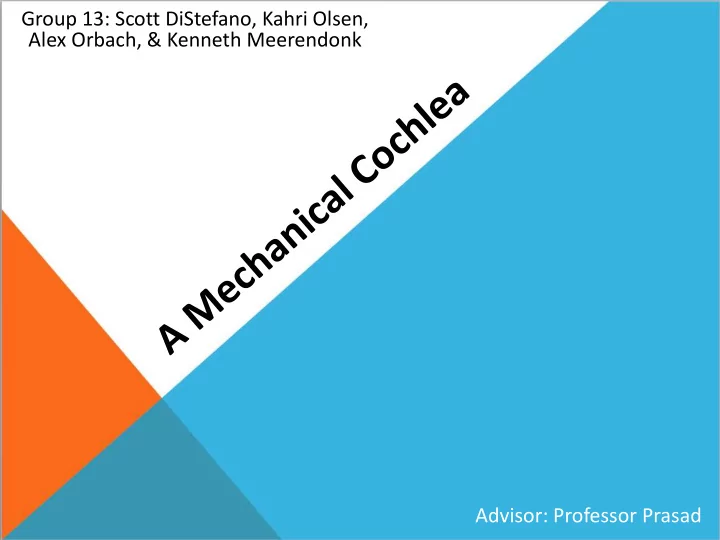

Group 13: Scott DiStefano, Kahri Olsen, Alex Orbach, & Kenneth Meerendonk Advisor: Professor Prasad
Table of Contents • The Human Cochlea • Types of Cochlea Damage • Existing Technologies • Conceptual Design 1 • Conceptual Design 2 • Comparison of Designs • Budget • Project Schedule • Conclusion
How Sound Is Processed The Human Cochlea
The Human Cochlea • Comprised of three fluid filled parts • Scala Vestibuli- perilymph fluid • Scala Tympani- perilymph fluid • Scala Media- endolymph fluid • Organ of Corti • Thousand of hair cells convert motion to electrical signals • Main Function • Collect sound waves from the external ear • Converts movement of hair cells into an electrical signal that are communicated to neurotransmitters • Electrical impulses become action potentials which travel along the auditory nerve to the brainstem Inside the human cochlea (Charles Gary Wright, Ph.D. and Peter S. Roland, M.D. )
Three Tiny Bones of the Middle Ear • Malleus • Attached to the mobile part of the ear drum • Receives vibration and starts oscillating motion • Incus • Acts as a bridge or connector from malleus to stapes • Transmits motion to the stapes • Stapes Bones of the inner ear. (Hearing Central) • Smallest named bone in the human body • Causes movement of the fluid inside the cochlea
Organ of Corti • Contains auditory sensory cells, or “hair cells” • Between 15,000-20,000 total • Transduces pressure waves to action potentials • Stimulate the spiral ganglion • Sends information to the auditory portion of the eighth cranial nerve • Travels to the brain for processing
What is Sensorineural Hearing Loss? • Damage to the inner ear nerves or hair cells • Permanent • Potentially caused by: – Genetics or abnormal inner ear development – Injury from medicine or disease – Tumor – Physical injury to the inner ear
Examples of Hair Cells Damaged Cochlea Normal Cochlea http://acousticsweb.com/education/demos/hearing_loss/hearing_loss.html
FACTS: • Approximately 17% of Americans (~36 million) suffer from some degree of hearing loss • 7.4% of Americans 29-40 years old suffer from hearing loss • “Cochlear implantation consistently ranks among the most cost-effective medical procedures ever reported.” • Average Cost of implants: $40,000 • “Net savings greater than $53,000 per child” The American Speech-Language Hearing Association
Existing Technologies www.thehearinginstitute.org
Existing Technologies
Problems with Existing Technologies • Currently no Exclusively Internal device • External Device creates buzzing/humming • External is non-aesthetic • Implants don’t replicate entire cochlea function www.terptopics.com/HearingAids.htm
Design Alternatives… CONCEPTUAL DESIGN 1 • Human cochlea acts as a bank of high Q resonators • Uses resonator bars in fishbone design (Tanaka, Abe & Ando) Resonator Bars
CONCEPTUAL DESIGN 1 cont. • Will be housed in non-rigid material, tapered to accommodate resonator bars • Human cochlea stops almost all reflections so only the purest sounds are picked up • Inside of housing will be sound absorptive The use of foams or rubbers will absorb sound (AcoustiProducts)
MATERIALS • Piezoelectrics – Quartz, PZT, PVDF • Lead zirconate titanate - ceramic (a) Structure of PZT; (b) under influence • Polyvinylidene fluoride – of an electric field (The Open University) thermoplastic polymer • Medical grade silicone • Acoustic foam or dense rubber Varying widths of silicone tubing (Qmed)
Resonance • Sound waves are mechanical oscillations of pressure through a solid, liquid or gas • Resonator bars move depending on each bars natural frequency 𝑙 𝑛 • NF of Bar = 2𝜌 (k=stiffness; m=mass) 𝑤 • NF of Sound = 4𝑀 The collapse of the Tacoma Narrows Bridge due to resonance (Science Clarified)
Circuitry & Calculations • Resistance will be found using 𝐺 𝑚−𝑧 𝑑 • Stress: 𝜏 = Wheatstone Bridge 𝐽 𝑑 • Change in Resistance: • Uses Kirchoff’s 1 st and 2 nd Laws 𝑚𝑚𝑓 6𝜌(𝑚− 2 ) ∆𝑆 𝑆 = 𝐺 𝑥𝑢 3 • High accuracy for known R’s, then high accuracy for found R
Design Alternatives… Conceptual Design Two Configuration of Design Two
Modeling the Cochlea Simpli lifi fica cati tions: ons: Single Linear fluid duct replaces complex spiral shape Duct dimensions constant along length Rigid structure Fluid interacts with only bottom of membrane Performan rformance ce Characteris cteristic tics: s: Position of maximum membrane distortion a function of incoming frequency Position to frequency mapping similar to that of the biological cochlea Output of sensors used to determine input frequencies Cross-section of Design Two Variation of membrane properties
Design Two Details Overview: • Simplified model of the biological cochlea • Single fluid filled duct housed within rigid structure • Flexible membrane with varying dimensions • Microphone input to generate incoming vibrations • Sensors along length of membrane which measure displacement due to pressure waves in fluid • Sensors are piezoelectric cantilevers • Design mimics hair cell function • Output voltage of each sensor varies with stress • Given beam dimensions, displacement at the tip can be calculated • LABView or similar program will receive and interpret output signals from device
Technical Analysis Helmholtz 2-D Equation: Design sign Parameter ameters: s: Partial Differential Equation Analysis obtained from Michigan University research: R. White and K. Grosh, Microengineered Hydromechanical Cochlear Model.
Design Evaluations Advantage ntages: s: Disadva dvantage ntages: s: • Responds to a wide range of Design 1 : • input frequencies No fluid to aid in the propagation of sound waves • Provides unlimited number of • Needs sound absorption inside output positions housing • Scaled-down implant size • Sensors are difficult to fabricate version possible using MEMS • Straightforward technical Design 2 : analysis • Precision/accuracy vary with calibration • Sensors outside of the fluid • Membrane increases design duct complexity
Expected Budget
Project Schedule
Recommend
More recommend